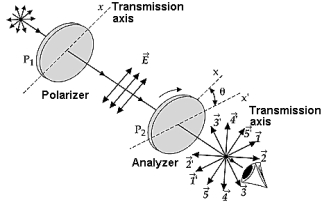Multiple Choice
 Two polarizing films are crossed with their transmission axes making an angle of = 20° with each other. The vectors that represent the plane-polarized wave train passed by the second polarizing film are
Two polarizing films are crossed with their transmission axes making an angle of = 20° with each other. The vectors that represent the plane-polarized wave train passed by the second polarizing film are
A)  -
-  '
'
B)  -
-  '
'
C)  -
-  '
'
D)  -
-  '
'
E) None of these is correct because no light passes through the second disk.
Correct Answer:
Verified
Related Questions

